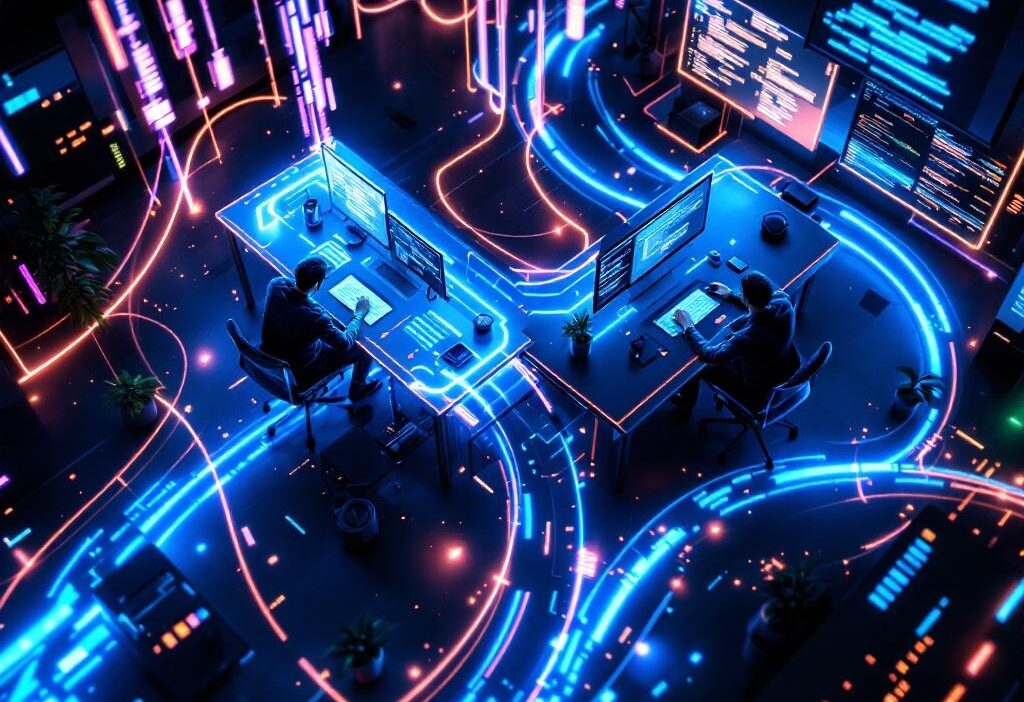The Side Effect Club: What 986 Million Code Pushes Reveal About Developer Workflow
What 986 Million Code Pushes Reveal About the Astonishing Evolution in Developer Workflow
- Nearly a billion code pushes signify a massive shift in developer workflows.
- Integration of Markdown and code writing enhances efficiency.
- AI tooling is streamlining tasks, making workflows smoother.
- Collaborative coding is the new norm, replacing solo efforts.
- The Rapidly Evolving Landscape of Developer Workflows
- Decoding the Tech Speak
- Professional Yet Fun: The New Mantra
- In Summation
- FAQ
The Rapidly Evolving Landscape of Developer Workflows
The developer workflow landscape has seen more changes than a chameleon on a rainbow. As developers, we’ve pushed colossal amounts of code, been through Github like a miner in a gold rush, and still managed to tweak, optimize, and revolutionize our routines. Our trusted AI Think Tool, Perplexity, has confirmed Markdown-to-code integration, AI-based tooling adoption, and the embrace of a more consistent, collaborative model in software development. And let me tell you, it’s more than just a fancy trend– think less Chandler Bing’s sarcastic one-liners, more tech revolution.
Decoding the Tech Speak
Okay, let’s take a breather. Deep-dive into the tech labyrinth can be like learning a new language, so let’s break this down as if we’re explaining it to a five-year-old:
- Markdown-to-code integration: Remember when you used to write code, and then separately document it? Say adios to that! Now, developers write docs and create code simultaneously, merging two tasks into one. Talk about killing two birds with one stone.
- Use of AI tooling: Tools like n8n, LangChain, and Pinecone are increasingly popular, being roped in to automate tasks. Imagine you’re a sorcerer, and these tools are your magic spells. Their use has led to improved efficiency and significantly cut down tedious manual efforts. Now, who wouldn’t love a magic trick like that?
- Collaborative and continuous delivery: Traditionally, coding was a solitary endeavor (a bit like Charlie Harper’s view on relationships). Now, it’s a team game, with constant tweaks and updates, a lovable mash-up of Friends and The Big Bang Theory, except for code.
Professional Yet Fun: The New Mantra
The time of hushed, studious silence in our coding cubicles is over. The developer’s workspace in 2025 is more vibrant than a unicorn’s daydream. It’s continuous, it’s collaborative, and it’s constantly optimizing for better. Let’s put it this way: we’ve traded our nerdy glasses for power capes, while still keeping the nerdy glasses because, you know, fashion.
In Summation
Melodrama aside, the truth is that developer workflow in 2025, powered by a relentless flurry of nearly a billion code pushes, has led to practices that emphasize integration, collaboration, and automation. No longer are developers confined to silos; they’re interconnected cogs in a fast-moving machine.
So, what’s your perspective on this evolution? Are you ready to hop onto this ‘Future Express’ or are you more comfortable in the traditional sepia-tinted world of coding solitude? I leave you to ponder over these exciting developments. Do remember, evolution is inevitable, be it dinosaurs or developers. Let’s make it fun, shall we?
P.S. If you want to know more about this subject, hit up the original source here: Github Blog Post.
FAQ
Q: What is the significance of Markdown-to-code integration?
A: It allows developers to write documentation and code simultaneously, increasing efficiency.
Q: How is AI influencing developer workflows?
A: AI tools are automating repetitive tasks, leading to enhanced productivity and creativity.
Q: Why is collaboration important in software development?
A: Collaboration fosters innovation and allows for quicker iterations, making code development a team effort instead of a solitary task.
Q: How has coding culture changed in recent years?
A: The coding culture has shifted from isolated work to a more vibrant and collaborative environment, making it more enjoyable and efficient.
























































































































































































































































